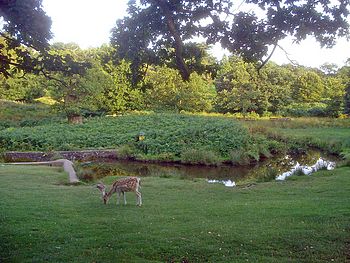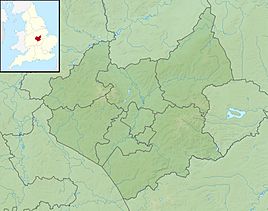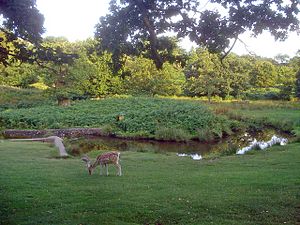River Lin facts for kids
Quick facts for kids River Lin |
|
|---|---|

The River Lin running through Bradgate Park
|
|
|
Location within Leicestershire
|
|
| Country | England |
| County | Leicestershire |
| Physical characteristics | |
| Main source | Ulverscroft |
| River mouth | River Soar Quorn 52°44′35″N 1°09′50″W / 52.74318°N 1.16381°W |
| Length | 17 km (11 mi) |
The River Lin is a short river in North Leicestershire, England. It starts in Ulverscroft, near Charnwood Forest. The river flows through famous places like Bradgate Park. It also helps fill important water supplies like Cropston Reservoir and Swithland Reservoir. The River Lin travels about 17 kilometres (11 miles) before it joins the River Soar in Quorn. It is known as one of Leicestershire's shortest rivers.
Where the River Lin Flows
The River Lin begins in the Ulverscroft Valley. Here, several small streams come together to form the river. At its start, the river is about 163 meters (535 feet) above sea level. Locals sometimes call this part the Ulverscroft Brook.
Long ago, water from the brook was used for Lord Stamford's Pond. The Stamford family owned a lot of land, including what is now Bradgate Park. The river also flowed near Ulverscroft Mill and provided water for Ulverscroft Priory.
As the river flows, it helps fill Cropston Reservoir, which provides drinking water. It then passes through the village of Newtown Linford. This village is actually named after the river! "Linford" means a place where you can cross the River Lin.
The river continues through the lower part of Bradgate Park. After leaving the park, it flows past Swithland Woods. Finally, the River Lin meets the River Soar near the town of Quorn.
Amazing Wildlife of the River Lin
The River Lin is a very healthy and important waterway. It provides a home for many different plants and animals. The river's clean water supports a variety of species.
- Fish: Many types of fish live in the river.
- White-clawed Crayfish: This special type of crayfish, which is rare in some places, can be found here.
- Deer: The river is a vital water source for the deer that live in the ancient deer park at Bradgate Park.
The River Lin is so important that it is part of a conservation area. This area is protected by the Leicestershire Wildlife Trust. This helps make sure the river and its wildlife stay healthy for the future.



